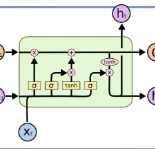We consider the multi-user detection (MUD) problem in uplink grant-free non-orthogonal multiple access (NOMA), where the access point has to identify the total number and correct identity of the active Internet of Things (IoT) devices and decode their transmitted data. We assume that IoT devices use complex spreading sequences and transmit information in a random-access manner following the burst-sparsity model, where some IoT devices transmit their data in multiple adjacent time slots with a high probability, while others transmit only once during a frame. Exploiting the temporal correlation, we propose an attention-based bidirectional long short-term memory (BiLSTM) network to solve the MUD problem. The BiLSTM network creates a pattern of the device activation history using forward and reverse pass LSTMs, whereas the attention mechanism provides essential context to the device activation points. By doing so, a hierarchical pathway is followed for detecting active devices in a grant-free scenario. Then, by utilising the complex spreading sequences, blind data detection for the estimated active devices is performed. The proposed framework does not require prior knowledge of device sparsity levels and channels for performing MUD. The results show that the proposed network achieves better performance compared to existing benchmark schemes.
翻译:我们认为,在无赠与非横向多重存取(NOMA)的链接中,多用户检测(MUD)问题是一个多用户检测问题,因为接入点必须确定活性Tings(IoT)装置的总数和正确身份,并解码其传输的数据。我们假设,IOT装置使用复杂的扩散序列,并在爆破差分模型之后以随机访问的方式传送信息,有些IOT装置在多个相邻时间段传送数据,其概率很高,而另一些装置则只在一个框架期间传送一次。利用时间相关性,我们建议用关注的双向长期存储(BILSTM)网络来解决MUD问题。BILSTM网络创建了使用前向和逆向LSTMs的装置启动历史模式,而注意机制则为装置启动点提供了必要的背景。通过这种方式,一些IOT装置在无赠予假想的情况下在多个相邻的时段传送数据,遵循一个等级路径。然后,通过利用复杂的传播序列,对估计活跃装置的盲点数据探测,我们提出一个双向的短期内存(BLSTMTMTMTMTM)网络,以解决的系统并不需要比现有的业绩系统,而需要更好的运行。



